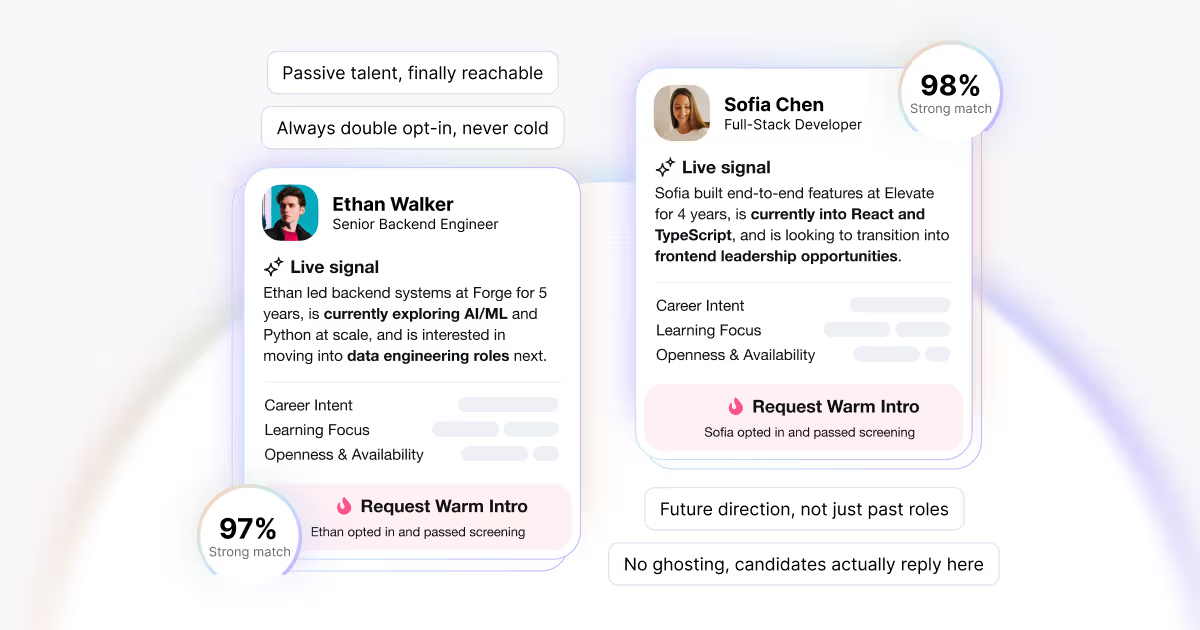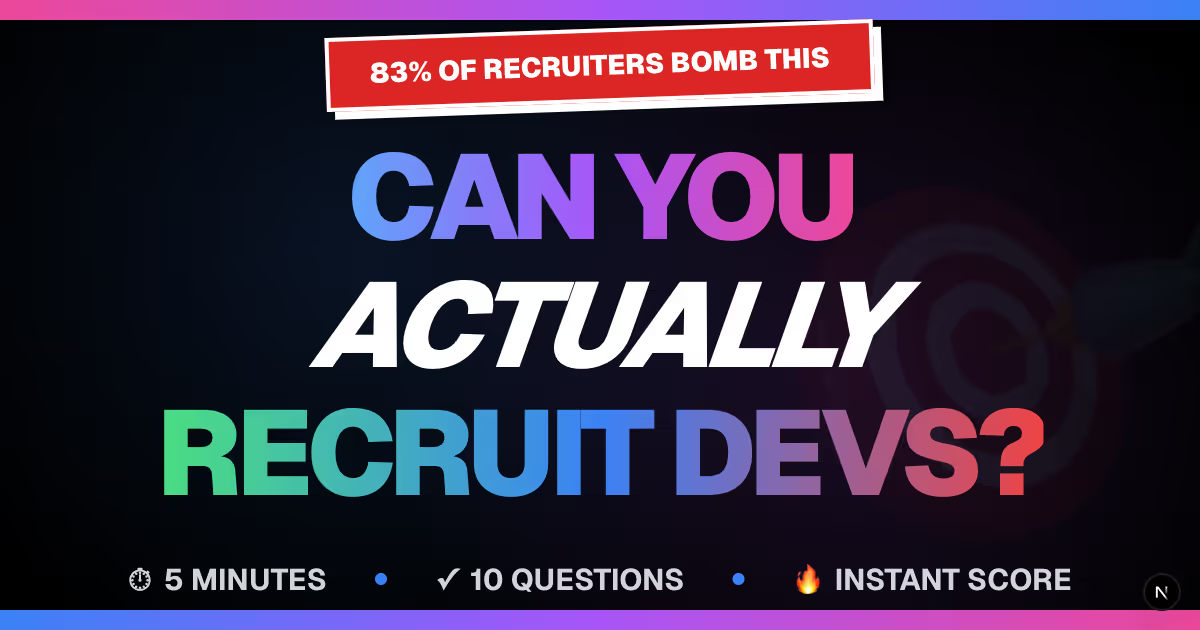


Personalized outreach in recruitment fosters trust and builds credibility, creating meaningful connections with developers in a crowded market.
Recruiting developers isn’t about sending mass messages anymore - it’s about making meaningful connections. Developers are bombarded with generic outreach, which often erodes trust. To stand out, recruiters need to focus on personalization. Here’s why it works:
- Personalized outreach goes beyond using a candidate’s name. It highlights their skills, projects, and career goals, showing genuine interest.
- Trust matters. Developers are more likely to respond when they feel understood, especially in a space filled with poorly targeted messages.
- Data supports this: Tailored messages have higher response rates and lead to better long-term relationships with candidates.
- Key strategies: Research candidates deeply, be transparent about roles, and align opportunities with their goals.
This isn’t just about hiring - it’s about building relationships that benefit both recruiters and developers.
Personalized Candidate Outreach for Recruiters Made Easy
How Personalization Builds Recruiter Credibility
Understanding how personalization works sheds light on why thoughtful outreach can foster trust and engagement. When developers receive messages that are tailored to their skills and interests, it shows that the recruiter has taken the time to understand their background and needs. This creates a strong foundation for building credibility through relevant communication and genuine interactions.
The Role of Relevance and Genuine Communication
Relevance is the cornerstone of effective recruitment communication. When a recruiter demonstrates a clear understanding of a developer’s technical expertise, career path, and professional interests, it sends a powerful message: the developer’s time and skills are valued. This stands in stark contrast to the impersonal, mass outreach methods that have become all too common in the industry.
The impact of relevant communication goes beyond just grabbing attention. Developers who receive messages that reference their specific skills, recent projects, or career milestones often experience what psychologists call cognitive resonance - the sense that the message was crafted just for them. This feeling of connection can foster trust and open the door to meaningful conversations.
Genuine communication also means acknowledging the developer’s current situation. Instead of assuming they’re actively searching for a new role, credible recruiters approach with an understanding that many top developers are satisfied in their current positions. This awareness shapes the tone of the outreach, making it feel more like a professional exchange rather than a hard sell.
Developers also recognize the effort behind personalized outreach. Crafting a message that reflects real research and understanding takes time, and this effort serves as a signal of quality. When developers see this level of care, they know the recruiter is serious about matching them with the right opportunity - not just meeting a quota.
The Problems with Generic Outreach
Generic outreach has created a major trust issue in developer recruitment. Mass messages that could apply to any software engineer signal to recipients that they’re just another name on a list. This approach erodes recruiter credibility in several ways.
First, generic messages fail to recognize what drives top developers. These professionals take pride in their specialized skills and unique contributions. When recruiters ignore these distinctions, they send the message that they don’t truly value the developer’s expertise.
The sheer volume of generic outreach adds to the problem. Many experienced developers receive dozens of untargeted recruitment messages every week. This barrage leads to what researchers call "recruitment fatigue", where developers grow increasingly resistant to engaging with any outreach - no matter how well-intentioned it might be.
Generic outreach also damages a company’s reputation. When recruiters send mass, untargeted messages under a company’s name, it can create negative brand associations. In tight-knit developer communities, word spreads quickly about companies with poor recruitment practices. Over time, this can make it harder for those companies to attract high-quality candidates.
There’s also the issue of wasted resources. Generic outreach often results in low response rates, which pushes recruiters to send even more messages, creating a vicious cycle. This not only clutters developers’ inboxes with irrelevant opportunities but also undermines the recruiter’s professional standing.
The Credibility Advantage of High-Context Introductions
Amid these challenges, high-context introductions offer a better way forward. Unlike cold outreach that relies on surface-level information, high-context introductions use detailed, relevant data about both the developer and the opportunity. This shifts the dynamic from an interruption to an invitation.
What makes high-context introductions so effective is their mutual benefit. Developers and recruiters enter the conversation with clear expectations and relevant insights. Developers know why they were chosen for a specific role, while recruiters understand the developer’s interests and career goals.
Systems that use warm, double opt-in contacts exemplify this approach. These platforms connect recruiters with developers who are already open to opportunities, starting every interaction with a shared context. Recruiters can reference a developer’s recent activity, such as contributions to open-source projects or engagement with specific technologies, which makes the outreach feel personalized and professional.
This model eliminates much of the guesswork that comes with traditional recruitment. Instead of blindly reaching out, recruiters can focus on presenting opportunities that align with the developer’s demonstrated interests. The result is a more respectful and efficient process that builds trust on both sides.
Double opt-in systems also give developers control over their visibility, which fosters trust and ensures that outreach is both relevant and welcome. High-context introductions naturally lead to conversations that feel organic rather than scripted. When a recruiter can reference a developer’s recent work or thoughtful commentary on industry topics, the interaction feels more like networking than a sales pitch. This approach not only builds credibility but also lays the groundwork for long-term professional relationships.
Core Elements of Effective Personalized Outreach
Crafting personalized outreach that earns trust and fosters meaningful connections requires focusing on three key elements. Together, these components elevate recruitment from generic mass messaging to thoughtful, professional conversations that respect both the developer's time and the recruiter's credibility.
Discovery: Understanding Developer Needs
The foundation of effective outreach lies in truly understanding what drives a developer. This means going beyond surface-level details like resumes or GitHub profiles. Recruiters need to dive deeper into a developer's professional motivations, career goals, and technical interests.
By examining recent projects, blog posts, or technical contributions, recruiters can uncover patterns that reveal a developer's aspirations. This approach acknowledges that many top developers aren’t actively seeking new roles but may be open to the right opportunity. The goal is to engage them in a professional dialogue about career growth, not pitch a job to someone who isn’t looking.
Discovery also involves identifying what matters most to the developer. Some might prioritize work–life balance, while others are drawn to opportunities for rapid career growth or access to cutting-edge technologies. These insights allow recruiters to craft outreach messages that feel personal and relevant.
Additionally, understanding a developer’s current role and company is crucial. This includes factors like compensation benchmarks, team dynamics, and potential pain points. Armed with this context, recruiters can present opportunities that address specific challenges or gaps, setting the stage for an open and honest conversation.
Transparency: Setting Clear Expectations
Transparency is the cornerstone of trust in recruitment. Developers value recruiters who are upfront about the role, team dynamics, compensation, and potential challenges right from the start.
Providing detailed information about the role prevents misunderstandings and mismatched expectations. Instead of vague phrases like "exciting startup opportunity", recruiters should offer specifics about the technology stack, team size, reporting structure, and responsibilities.
Acknowledging potential challenges - such as legacy code maintenance, tight deadlines, or a steep learning curve - further builds credibility. Developers appreciate honesty and a balanced perspective, which shows respect for their time and decision-making process.
Beyond the basics, sharing details about equity, benefits, and growth potential demonstrates a genuine commitment to transparency. Clear communication about the hiring process - such as the number of interview rounds, technical assessments, and timelines - helps developers plan and engage more effectively.
Positioning: Aligning Opportunities with Developer Goals
Once discovery and transparency are in place, the final step is presenting opportunities in a way that aligns with a developer’s interests and career aspirations. This involves synthesizing the insights gathered during discovery and framing them with clarity and honesty.
Effective positioning highlights how a role matches the developer’s demonstrated interests. For example, if a developer’s GitHub profile shows a focus on machine learning, the recruiter should emphasize the machine learning aspects of the role and the expertise of the team. Similarly, if their writing reflects an interest in scaling challenges, the recruiter can spotlight the company’s growth trajectory and infrastructure needs.
Career progression is another critical factor. Developers who have transitioned into leadership roles may prioritize opportunities for management, team-building, or strategic decision-making. Positioning should reflect how the role supports their growth and ambitions.
For developers who recently joined their current company, immediate moves might not be appealing. However, acknowledging their current commitments and suggesting a longer-term relationship can open the door for future opportunities.
Platforms that enable warm, double opt-in introductions excel at this stage. By providing rich context about both parties, these tools allow recruiters to align roles with precision. For example, daily.dev Recruiter facilitates introductions based on a developer’s expressed interests, ensuring outreach is tailored rather than speculative. This approach fosters trust and relevance, making conversations more meaningful for everyone involved.
sbb-itb-d1e6221
Methods for Personalizing Developer Recruitment
Personalized outreach leads to higher response rates because it shows genuine effort and understanding. The best strategies combine psychological insights with practical actions that reflect real interest and professional credibility.
Using Social Proof and Developer Stories
Social proof is a powerful way to build trust, especially when paired with relatable developer stories. Instead of relying on generic testimonials, recruiters can share specific examples that resonate with developers. For instance, a story about a senior engineer leaving a corporate job for a startup to rediscover their passion for coding can address common fears about career transitions while showcasing positive outcomes.
Developers often connect with stories that highlight technical achievements or career growth. Sharing examples of how candidates contributed to measurable improvements - like boosting system performance or streamlining processes - can underscore a company's dedication to technical expertise and the meaningful impact new hires can have.
Developer communities and peer networks are excellent sources for authentic social proof. These platforms naturally foster trust because the testimonials and experiences come directly from fellow developers. Unlike polished marketing materials, these organic stories carry more weight and credibility.
Applying the Reciprocity Principle
The reciprocity principle is another effective tool in recruitment. This psychological concept suggests that people are more likely to engage when they feel they've received value first. For recruiters, this means offering something meaningful before asking for a developer's time or consideration.
Providing career insights or market intelligence is a great way to add value. Sharing salary benchmarks, trends in emerging technologies, or advice on specific career paths positions recruiters as knowledgeable allies rather than just someone trying to fill a role.
Another way to create value is by offering technical resources or learning opportunities. Sharing articles, conference talks, or open-source projects tailored to a developer's interests shows that the recruiter cares about their professional growth, not just filling a vacancy.
Facilitating introductions to peers, mentors, or industry experts is another way to build goodwill. These connections, even if unrelated to a specific job opportunity, establish long-term relationships based on mutual benefit rather than short-term transactions.
By focusing on timely and authentic value - whether through insights, resources, or networking - recruiters can build trust without expecting anything in return right away.
High-Context, Double Opt-In Introductions
High-context, double opt-in introductions are a standout method for ensuring outreach feels relevant and welcome. This approach involves connecting developers and recruiters only when both parties have explicitly expressed interest, and there’s enough context for a meaningful conversation. It avoids the impersonal nature of cold outreach and makes every interaction purposeful.
These introductions work best when they include detailed background information. For example, referencing a developer's specific interests or career goals provides clarity on why the connection makes sense. This level of personalization ensures that outreach feels thoughtful rather than random.
The double opt-in mechanism respects developers' time and autonomy. By confirming interest from both sides before initiating contact, recruiters avoid making developers feel pressured or ambushed. When developers signal their openness to certain opportunities, recruiters can confidently reach out, knowing the timing and context are right.
Real-time engagement data also plays a role here. By referencing a developer's recent activity - like a project they contributed to or an article they shared - recruiters have natural conversation starters that feel relevant and timely.
Platforms like daily.dev Recruiter exemplify this approach by connecting recruiters with developers based on their actual interests and activity within their professional network. Instead of guessing developer preferences, the platform enables introductions that align with developers' expressed interests.
Ultimately, high-context introductions succeed because they respect developers' time and preferences. When conversations are initiated with mutual interest and clear purpose, they tend to be more productive and lead to better outcomes for everyone involved.
Measuring the Impact of Personalization
Tracking the results of personalized recruitment strategies is essential for understanding their effectiveness. Without clear metrics, recruiters can't fine-tune their methods or demonstrate the value of customized outreach.
Key Metrics for Evaluating Personalized Outreach
One of the most telling metrics is the response rate - the percentage of developers who reply to initial messages. A higher response rate often means that the message resonated with recipients and felt relevant to their needs or interests.
Another critical factor is the quality of engagement. It’s not just about whether a developer responds but also about the depth of those interactions. For instance, long email exchanges or detailed follow-up discussions can indicate genuine interest and alignment.
The conversion rate - how many initial conversations lead to interviews or assessments - is another key indicator. This metric shows how well personalized messages align with candidates' goals and interests.
Time-to-hire is also worth monitoring. By targeting candidates who are already a strong match, personalized outreach can speed up the hiring process, reducing the time from the first contact to a job offer.
Additionally, candidate feedback gathered through satisfaction surveys offers valuable insights. High satisfaction scores reflect a positive experience, even if the candidate doesn’t accept the role. This can also strengthen the employer brand.
Lastly, long-term metrics like quality of hire - measured by performance, retention, and feedback from managers - provide a broader look at how well personalized recruitment identifies the right candidates for the organization.
By focusing on these metrics, recruiters can better understand how personalized strategies outperform generic approaches.
Comparing Personalized and Generic Outreach
While exact numbers will vary between companies, research consistently shows that personalized outreach delivers clear advantages over generic methods:
- Higher response rates: Candidates are more likely to reply when the outreach feels tailored to them.
- Improved candidate progression: Personalized messages often lead to more candidates advancing to interviews and later stages.
- Faster engagement: Tailored communication can speed up the initial connection, often leading to shorter hiring timelines.
- Better candidate satisfaction: Personalized messages are seen as thoughtful and respectful, leaving a positive impression.
Generic outreach, on the other hand, often lacks the specificity needed to build trust and credibility. In contrast, referencing a candidate’s specific skills, projects, or career aspirations in a tailored message can establish rapport quickly.
Platforms like daily.dev Recruiter take this approach seriously, ensuring every candidate introduction is high-context and double opt-in. This commitment to meaningful, relevant communication not only boosts immediate engagement but also leads to stronger long-term hiring outcomes.
While personalized outreach does require more effort, the payoff is clear: deeper connections, better engagement, and ultimately, more successful hiring results.
Building Trust Through Personalization
Personalization isn't just a nice-to-have in recruitment - it’s a cornerstone for building trust. Studies highlight that when recruiters take the time to truly understand a developer’s background, interests, and career goals, it sends a clear message: the candidate is valued as an individual, not just another entry in a database.
Trust grows when developers sense that recruiters have done their research. Mentioning specific projects, preferred tech stacks, or career milestones shows effort and respect. On the other hand, generic outreach screams mass communication, instantly eroding credibility before a relationship even begins. Taking the time to go beyond surface-level details sets the stage for meaningful conversations.
True personalization doesn’t stop at acknowledging a developer’s current role. It’s about connecting the dots between their career aspirations and the opportunities being presented. When a recruiter can explain why a role aligns with a developer’s goals, the conversation naturally shifts from being transactional to consultative.
High-context communication further reinforces this tailored approach. Double opt-in introductions, paired with relevant background information, show respect for a developer’s time and priorities. This method not only demonstrates effort but also highlights the recruiter’s commitment to thoughtful, personalized engagement.
The benefits of personalized outreach extend well beyond a single interaction. When developers have positive experiences, they’re more likely to stay engaged and even recommend the recruiter to others in their network. Over time, this trust compounds, making future recruitment efforts smoother and more effective.
Platforms like daily.dev Recruiter exemplify this approach by ensuring every introduction is warm, double opt-in, and thoughtfully contextualized. By engaging developers where they already spend time - whether reading, learning, or interacting with content - the platform fosters natural, meaningful conversations instead of intrusive cold outreach.
Personalization doesn’t just lead to immediate hiring success; it builds long-term relationships. Developers remember recruiters who treat them with professionalism and respect, even if they don’t accept a specific role. This reputation becomes a powerful advantage when attracting top talent.
Ultimately, personalization transforms recruitment from a numbers game into genuine relationship-building. With trust as the foundation, both recruiters and developers benefit from deeper connections and better outcomes.
FAQs
How can recruiters personalize outreach to developers effectively?
Recruiters aiming to make their outreach more effective should start by delving into a developer's online presence - this might include platforms like GitHub, personal websites, or professional profiles. Take note of their skills, recent projects, and interests to create messages that resonate on a personal level.
Look for details like open-source contributions, activity on developer communities, or any technical content they've shared. When your communication reflects an understanding of their expertise and aligns with their career aspirations, it not only establishes trust but also greatly improves the likelihood of receiving a thoughtful reply.
What are high-context introductions in recruitment, and why do they work?
High-context introductions in recruitment aim to establish trust and rapport by leaning on shared connections, values, or subtle communication cues. For instance, a recruiter might reference a mutual professional contact, acknowledge a candidate’s recent accomplishment, or bring up a shared interest to create a sense of familiarity.
This approach works well because it makes candidates feel recognized and appreciated, which helps build trust and credibility. By personalizing their outreach to align with the candidate’s background and preferences, recruiters can create more engaging interactions that pave the way for stronger relationships and more successful outcomes.
How does personalized outreach strengthen relationships between recruiters and developers?
Personalized outreach allows recruiters to form deeper connections with developers by building trust and genuine rapport. When recruiters craft tailored messages, it demonstrates a sincere understanding of the developer’s unique skills, experiences, and career aspirations. This thoughtful approach sets the stage for meaningful, ongoing engagement.
By prioritizing well-thought-out, context-rich communication instead of sending generic messages, recruiters can establish credibility and create a lasting impression. Over time, this strategy not only strengthens professional relationships but also fosters loyalty and opens the door for valuable referrals, creating a win-win for everyone involved.
Related Blog Posts








